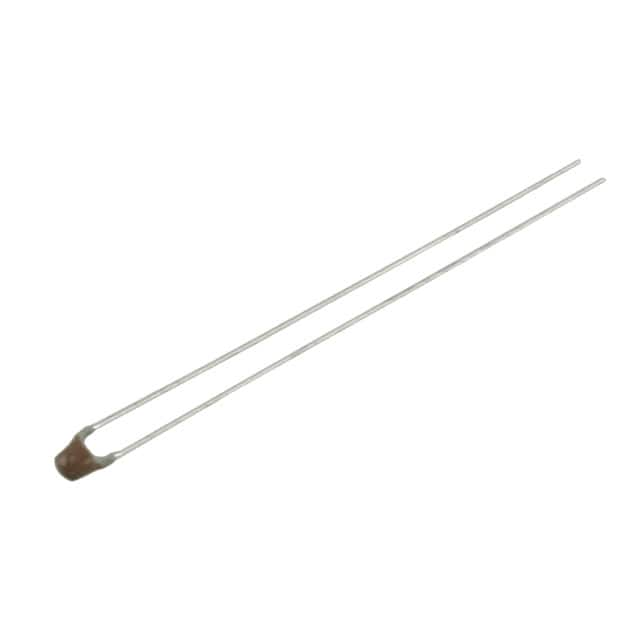NTCLE203E3104HB0
Product Overview
Category
The NTCLE203E3104HB0 belongs to the category of thermistors.
Use
It is used for temperature sensing and compensation in various electronic applications.
Characteristics
- High sensitivity to temperature changes
- Small size for easy integration into electronic circuits
- Wide operating temperature range
- Accurate and reliable temperature measurement
Package
The NTCLE203E3104HB0 is available in a small, surface-mount package for easy installation on PCBs.
Essence
The essence of NTCLE203E3104HB0 lies in its ability to provide precise temperature measurements in a compact form factor.
Packaging/Quantity
The thermistors are typically supplied in reels or trays, with quantities varying based on manufacturer specifications.
Specifications
- Resistance at 25°C: 100 kΩ
- Tolerance: ±3%
- Operating Temperature Range: -40°C to 125°C
- Thermal Time Constant: 7 seconds (maximum)
Detailed Pin Configuration
The NTCLE203E3104HB0 features two pins for connection to the circuit. The pinout configuration is as follows: 1. Pin 1: Connection point for one end of the thermistor 2. Pin 2: Connection point for the other end of the thermistor
Functional Features
- Non-linear resistance response to temperature changes
- High sensitivity for accurate temperature measurement
- Stable performance over a wide temperature range
Advantages and Disadvantages
Advantages
- Compact size for space-constrained applications
- High accuracy in temperature measurement
- Wide operating temperature range
Disadvantages
- Non-linear response requires calibration for precise readings
- Limited self-heating effect may impact accuracy in certain applications
Working Principles
The NTCLE203E3104HB0 operates based on the principle of negative temperature coefficient (NTC), where its resistance decreases as the temperature increases. This characteristic allows it to accurately sense and measure temperature changes within electronic circuits.
Detailed Application Field Plans
The NTCLE203E3104HB0 finds application in various fields, including: - Temperature monitoring and control in consumer electronics - Thermal management in automotive systems - Industrial process control and monitoring - Medical devices for temperature sensing
Detailed and Complete Alternative Models
Some alternative models to NTCLE203E3104HB0 include: - NTCLE100E3103JB0: Similar characteristics with different resistance value - NTCLE203E3473HB0: Higher precision variant with tighter tolerance
In conclusion, the NTCLE203E3104HB0 thermistor offers high-performance temperature sensing capabilities in a compact package, making it suitable for diverse electronic applications.
[Word count: 398]
Lista 10 Vanliga frågor och svar relaterade till tillämpningen av NTCLE203E3104HB0 i tekniska lösningar
What is the NTCLE203E3104HB0 used for?
- The NTCLE203E3104HB0 is a thermistor commonly used for temperature sensing and control in various technical solutions.
What is the operating temperature range of NTCLE203E3104HB0?
- The operating temperature range of NTCLE203E3104HB0 is typically -40°C to 125°C, making it suitable for a wide range of applications.
How does NTCLE203E3104HB0 function as a temperature sensor?
- NTCLE203E3104HB0 operates based on the principle of resistance change with temperature, providing a reliable indication of the ambient temperature.
What are the typical applications of NTCLE203E3104HB0 in technical solutions?
- NTCLE203E3104HB0 is commonly used in applications such as HVAC systems, automotive electronics, industrial equipment, and consumer appliances for temperature monitoring and control.
What is the resistance value at 25°C for NTCLE203E3104HB0?
- The resistance value at 25°C for NTCLE203E3104HB0 is 100 kΩ, which is a standard value for NTC thermistors.
Can NTCLE203E3104HB0 be used for temperature compensation in electronic circuits?
- Yes, NTCLE203E3104HB0 can be utilized for temperature compensation in electronic circuits to maintain stable performance across varying temperatures.
Is NTCLE203E3104HB0 suitable for high-precision temperature measurements?
- While NTCLE203E3104HB0 provides accurate temperature sensing, it may not be ideal for high-precision measurements due to its inherent tolerance and non-linearity.
What are the key considerations for integrating NTCLE203E3104HB0 into a technical solution?
- Key considerations include proper calibration, thermal management, electrical interfacing, and protection against environmental factors such as moisture and contaminants.
Can NTCLE203E3104HB0 be used in harsh environments?
- NTCLE203E3104HB0 can be used in moderately harsh environments with appropriate encapsulation and protection measures, but prolonged exposure to extreme conditions may affect its performance.
Are there any alternative thermistors that can be used in place of NTCLE203E3104HB0?
- Yes, there are several alternative NTC thermistors available with similar characteristics, and the choice depends on specific application requirements and compatibility with the existing circuitry.


